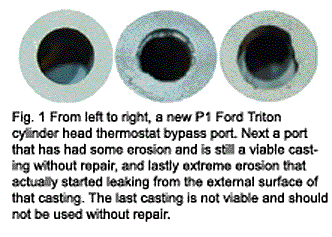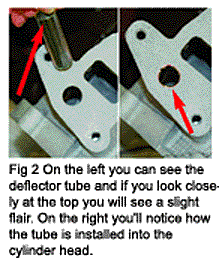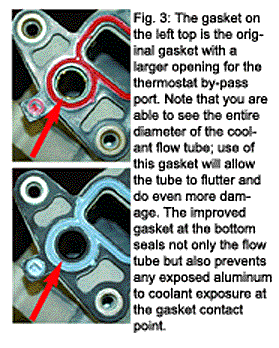As much fun as it is to play detective, research obscure facts and unravel engineering messes myself, sometimes I totally enjoy running across things that just plain make sense.
Often, many of these things are after-the-fact thoughts, but that is why hindsight is always 20/20. For those in the engineering world, these would be running changes, technical improvements and developments or improved reliability changes, but all of them mean the same thing: we found a problem and we fixed it.
The following information is in reference to the thermostat bypass port that is found only on the left side cylinder head of all PI (Performance Improved) Ford Triton engine applications; the 4.6L and 5.4L V8 engines as well as the 6.8L V10.

Let’s start with the problem: poorly maintained coolant will become acidic and/or alkaline, and a poor engine ground will allow the coolant to become charged. Each of these is just one of the potential coolant corrosion problems facing these engines, and both of these will have a caustic effect on aluminum. The result is erosion of coolant ports which may cause a gasket leak and/or coolant leak of the casting integrity itself (see Figure 1).
Ford has made a couple of improvements to help eliminate the erosion in the thermostat bypass port. One is the addition of an anodized steel thin wall flow tube. This insert (p/n 1L3Z-6G017-AA) has a slight flare at the top to seat it into the coolant bypass port (see Figure 2).

Next a change was made to the intake manifold gasket. Not only does this accommodate and hold the tube in place, for a cylinder head that does not have the tube installed it creates a much better seal in that area. This intake gasket upgrade happened in 2001 and you would think that everyone would know about it by now.
The part number for this gasket is 1L3Z-9439-BA and I have only been able to locate it in the aftermarket from Federal-Mogul/Fel-Pro (p/n 96281) and in manifold sets MS9628 and MS9628-1 for the V8 applications.
If you look carefully at the photos in Figure 3 you will see that there is an additional layer of rubber that makes the gasket passage smaller but has no impact on the bypass port.
Therein lies the fallacy; there are many references to this later gasket as a “restricted port” gasket but this is not the case. It is simply an improved sealing and retention device for the flow tube.

Another option is that the right side cylinder head is not impacted by this scenario. Therefore, if the left side head has erosion you do have the choice of using it on the right side and the right head on the left side. Obviously if you’re selling cylinder heads as individual components the erosion will need to be repaired and the intake surface machined.
This information would not have been possible without the help of Doug Anderson at Grooms Engines in Nashville, TN.
Remember that you can obtain this information and more from the online interactive research tool, EngineDataSource.com. And right now, you may access this information on the 30-day free trial.
For technical questions, or to learn more about the 30 day free trial of EngineDataSource, contact the Production Engine Remanufacturers Association (PERA) at: [email protected]













